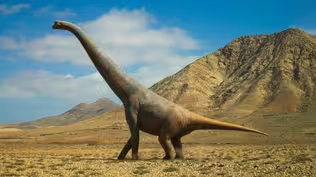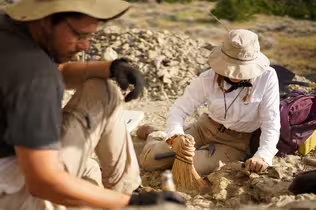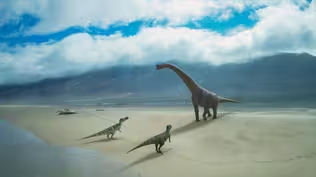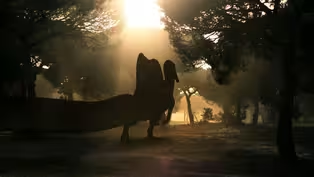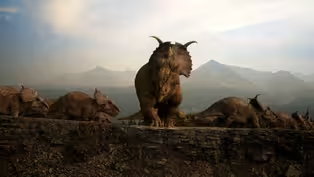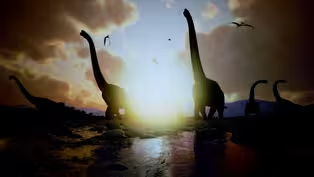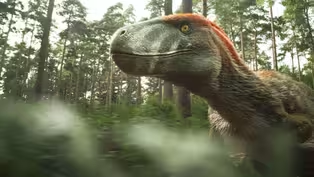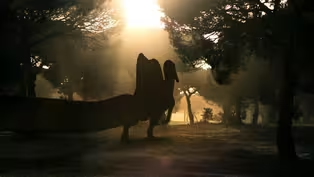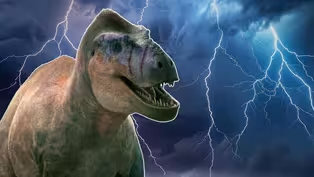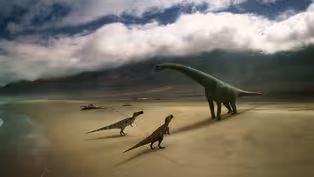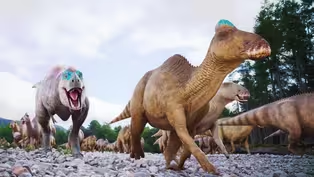
When Dinosaurs Ruled the Arctic Circle
Special | 5m 52sVideo has Closed Captions
Very few dinosaurs made it as far North as the Arctic Circle...except for two.
Pachyrhinosaurus and Edmontosaurus - undertook an epic migration every year to reach the fertile grounds of the northern latitudes in summertime. This was far from an easy task. Deadly predators lurked nearby looking to pick off weaker members of this giant herd. But evidence is starting to suggest that these two maybe have used their complementary strengths to fend off predators and communicate.
Problems playing video? | Closed Captioning Feedback
Problems playing video? | Closed Captioning Feedback
Narrator: Shane C. Campbell-Staton With Thanks: Philip J Currie Dinosaur Museum Digital Producer & Director: Mark Atwill Digital Producer: Tom Heyden Post Production: Envy Post Production Visual Effects: Lola Post...

When Dinosaurs Ruled the Arctic Circle
Special | 5m 52sVideo has Closed Captions
Pachyrhinosaurus and Edmontosaurus - undertook an epic migration every year to reach the fertile grounds of the northern latitudes in summertime. This was far from an easy task. Deadly predators lurked nearby looking to pick off weaker members of this giant herd. But evidence is starting to suggest that these two maybe have used their complementary strengths to fend off predators and communicate.
Problems playing video? | Closed Captioning Feedback
How to Watch Walking with Dinosaurs
Walking with Dinosaurs is available to stream on pbs.org and the free PBS App, available on iPhone, Apple TV, Android TV, Android smartphones, Amazon Fire TV, Amazon Fire Tablet, Roku, Samsung Smart TV, and Vizio.
Providing Support for PBS.org
Learn Moreabout PBS online sponsorshipMore from This Collection
Check out our 12 digital exclusives from our series Walking with Dinosaurs with BBC.
We Were Wrong About Spinosaurus
Video has Closed Captions
Millions of years ago, dinosaurs ruled the Earth. But underwater it was a totally different world. (6m 36s)
Were Dinosaur Brains Designed For Combat?
Video has Closed Captions
Did Pachyrhinosaurus bones always gather in such great numbers? (5m 42s)
How We Solve Jurassic Mysteries from One Bizarre Fossil
Video has Closed Captions
Would you lick a 65-million-year old dinosaur poop? (5m 19s)
How Walking with Dinosaurs Created the Most Accurate Dinos Ever
Video has Closed Captions
Join the team behind the scenes! (6m 32s)
How to Find a Dinosaur that Hollywood Dreamed Up
Video has Closed Captions
What would make a Utahraptor so much larger than other raptor species? (5m 50s)
How the Walking with Dinosaurs Team Brought a Dinosaur Back to Life
Video has Closed Captions
The Walking With Dinosaurs team reveal how they created the Spinosaurus. (5m 50s)
How Extreme Weather Is Revealing — And Destroying — Dinosaur Fossils
Video has Closed Captions
Imagine finding a rare fossil that you’ve been desperate to find - only for it to be put at risk. (5m 59s)
How an Evolutionary Arms Race Created Bizarre Dino Designs
Video has Closed Captions
It’s grudge match time. Except that this one took place over millions of years. (5m 32s)
The Dinosaurs that Could Cross the Atlantic
Video has Closed Captions
How did dinosaur fossils get there? (5m 42s)
Did Dinosaurs Abandon Their Young to Help Them Survive?
Video has Closed Captions
In late Cretaceous Alberta, many apex predators roamed free, so how did the prey survive? (5m 45s)
Did a Meteor Kill All the Dinosaurs?
Video has Closed Captions
Did the asteroid kill the T. rex and Triceratops? (5m 42s)
Providing Support for PBS.org
Learn Moreabout PBS online sponsorship-[Narrator] Survival of the fittest often sounds like a fight to the death.
But for two species of dinosaur, the opposite was true.
This is the story of how they allied together to fend off predators in their march towards the Arctic Circle.
Pachyrhinosaurus and Edmontosaurus were two big herbivores who have been found as far north as modern-day Alaska.
They lived in gigantic groups of up to 40,000 strong.
And each year, both herds undertook epic migrations, heading right towards the Arctic Circle.
But new discoveries suggest that these two species were much more than coincidental travel companions.
-[Henry] Here it is, an impossibly good dinosaur fossil.
-[Narrator] One spectacular find could hold the key to unlocking the secrets [deep bellows] of how two totally different species worked together to survive such a dangerous journey.
-[Henry] This is the closest thing you can get to seeing a living dinosaur in the wild.
-[Narrator] But why would they make such a journey in the first place?
The simple answer is food and sunlight.
Seventy-three million years ago, these dinosaurs lived in a very different North America, one split in half by a huge impassable sea known as the Western Interior Seaway.
Pachyrhinosaurus and Edmontosaurus lived right here.
Hemmed in by mountains on one side and the sea on the other, they were unable to get to warmer climes farther south, which made their winters brutally harsh, so harsh that you can even see it in their bones.
Every winter, their growth would slow down so much that you can literally see it under a microscope, similar to counting tree rings.
But in the spring, their fortunes changed as they headed further north towards the Arctic.
Bleak and dark in winter, in the summer, the prehistoric Arctic became a paradise, where sunlight 24 hours a day helped produce bountiful supplies of vegetation.
But reaching the promised land was far from easy.
This migration was fraught with danger.
Packs of tyrannosaurs lurked nearby, waiting for an opportunity to pick off a member of the herd.
So maybe Pachyrhinosaurus and Edmontosaurus traveled together for safety in numbers.
But palaeontologists like Henry Sharpe think they were more than just travel companions and allied with each other to fend off predators using their complementary strengths.
-[Henry] If you were an Albertosaurus trying to sneak in and get an easy meal, it would be much harder if they had the vision of Edmontosaurus and the armaments of Pachyrhinosaurus all together in the same area.
-[Narrator] This theory of cross-species cooperation isn't so wild when you consider the natural world today.
In the Serengeti, zebras and wildebeest form a similar alliance, using zebras' better vision to spot danger, with wildebeest providing the muscle.
-[Henry] It's called mutualism.
It's animals benefiting off the presence of another.
It's ridiculous to suggest that dinosaurs didn't do that in some regard when we understand how frequent it is in modern animals.
So, I definitely expect herds of Pachyrhinosaurus and herds of Edmontosaurus to be using the presence of the other to increase their own safety.
-[Narrator] But just how far did this dinosaur alliance go?
Thanks to a unique Edmontosaurus skull, Henry thinks this wasn't just about moving together or even relying on each other's physical strengths.
They may have actually been talking to each other.
-[Henry] This is a dinosaur mummy.
This is, uh, the closest thing you can get to seeing a living dinosaur in the wild.
-[Narrator] This rare, mummified skull has been preserved with some of its soft tissue intact, offering a window into this dinosaur's biology.
-[gasps] It's so cool.
I mean, the chances of an animal being fossilized are one in a million.
And the chances of that fossil having skin like this is one in a billion.
Just an impossibly good dinosaur fossil.
-[Narrator] The skull has its cranial crest intact, which Henry thinks could have been used to send visual warning signals to other herd members.
-[Henry] We're looking at what this animal is using to communicate.
We're speaking dinosaur right now.
We're, we’re saying hi, you know.
We're paying attention to the crest that it wants everyone to pay attention to.
It's a billboard.
It's trying to say, hey, look at me, pay attention to me.
The signaling that these dinosaurs were doing could definitely be translated between an Edmontosaurus and a Pachyrhinosaurus.
We just didn't think that Edmontosaurus had anything like that until this specimen was found.
-[Narrator] There's still a long way to go before we can understand how much different dinosaur species were able to communicate with each other.
-This guy's kind of the, the Rosetta Stone for understanding that aspect of dinosaur biology.
-[Narrator] It's possible that survival of the fittest on prehistoric Earth might have been less about hunting one another and more about working together.
[deep bellows]

- Science and Nature

Explore scientific discoveries on television's most acclaimed science documentary series.

- Science and Nature

Capturing the splendor of the natural world, from the African plains to the Antarctic ice.












Support for PBS provided by:
Narrator: Shane C. Campbell-Staton With Thanks: Philip J Currie Dinosaur Museum Digital Producer & Director: Mark Atwill Digital Producer: Tom Heyden Post Production: Envy Post Production Visual Effects: Lola Post...

